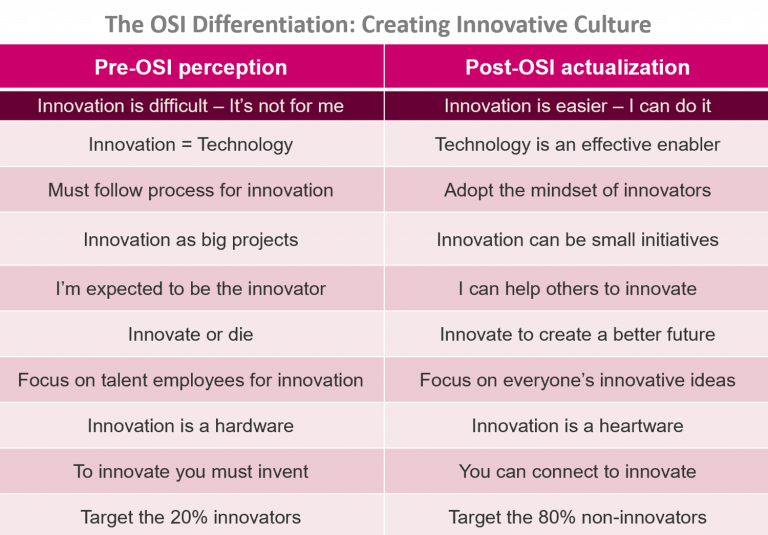To be an innovator, you must constantly be asking the question: “What doesn’t make sense?”.
Mine was: “Why is innovation such a stigmatized word? Considering how important innovation is to the growth, or survival, of organizations, why do most employees I have met are so turned off by being an innovator?”.
I recently asked a CEO of a medium-sized organization his view on innovation. “On a scale of 1-5, one being the least and five being the most, how would you rate the importance of innovation for your organization?” “Five,” was his reply. This means innovation is very important. “Okay then, on a scale of 1-5, one being never and five being always, how would you rate the frequency of innovation made by your people?” I asked. “Two,” was the answer. This means innovative ideas from his people are a rarity.
Question 1: ONE A SCALE OF 1-5, HOW IMPORTANT IS INNOVATION TO YOUR ORGANISATION
Answer: 55% said the most important. 38% rated it as important. Overall, 88% gave either a four or a five.
Question 2: ON A SCALE OF 1-5, HOW OFTEN DO PEOPLE IN YOUR ORGANISATION INNOVATE?
Answer: 55% said occasionally, 26% rated it as rarely. Overall 81% gave either a three or a two.
I have read a lot of books on innovation – one common thread is they stress the importance of taking risks, failing fast, and experimentation. But most organizations struggle to instill these behaviors, and subsequently innovation initiatives – as evident in both the CEO’s answer and my audience poll. Why the disparity? My working hypothesis is that the culprit is in people’s heads. Innovation has been so hyped as the game-changing task that it scares most ‘normal’ employees away from even attempting it.
A blog by innovationinpractice.com shares a similar view: “Participants in the innovation space tend to perpetuate a mystique about innovation and creativity as though it is a deeply hidden secret that needs to be unleashed.” According to the interviewer, Fortune 100 executives described innovation champions as “altruistic ‘dreamers’ who are out of touch with the business” and that “business people shy away from championing innovation because they believe the stigma of failing at innovation is more career-damaging than failing at other ventures.”
Whether this hypothesis is true, the only way to know is to test it. Iclif has launched a program on innovation called ‘Open Source Innovator’ or ‘OSI’ to address this stigma.

Having experienced the program with employees from various organizations across different countries, here are my key learnings:
1) Innovation is indeed stigmatized: My diverse group of participants initially shared a common skepticism towards innovation – or specifically the idea of THEM being the innovators. Most viewed that innovation is too big a word, too expensive, and too difficult for them to try. In fact, I shared an airport ride with a participant who told me that his company “should have sent people higher up” to the course because he himself was “in no position to innovate anything”.
After the program, we have tamed the innovation monster. Here is a comment made by an attendee from a financial service provider: “The true meaning of Open Source Innovator or (OSI) that we learned is the new kind of innovation, which is driven by ‘empathy and compassion’ to invent, to create, or to do something good for others, for the better society, for the better environment, for the better future, and for the better world. Everyone can do it; even a little single thing surrounding us, as long as we have a strong will power to do it. We all can make it happen. Empathy is a skill.”
2) You don’t have to be a techie to innovate: My client reps told me that the companies they approached tend to send people who are ‘in tech’ to innovation courses. Similarly, candidates who did not consider themselves to have high technology interest or expertise would excuse themselves from signing up. While this used to be true, it no longer applies in the current Open Source era. There exists such an abundance of platforms that whatever idea you may have, there is someone out there offering support. Whether it is 3D printing, making online videos, or setting up e-commerce, the possibilities to turn ideas into reality is literally at our fingertips. OSI targets the 80% non-techies, not the 20% who are already writing codes.
In fact, Greg Satell, the author at Mapping Innovation, wrote several articles on this technological liberalization. One, aptly titled ‘The Future of Software Is No-Code’, describes the different services already available that empower people who do not know how to code to write programs.
3) We can always help others to innovate: One way to un-stigmatize, i.e. make innovation easier, is to shift the pressure from employees being innovators to employees being think buddies. It is much easier to help others than having to do it yourself. The aim of this approach is to support employees to help each other to innovate. My previous piece, Get Your Employees A Think Buddy To Capture Innovation, explores the skillset that is needed to create such an environment. To be a Think Buddy, employees need to learn to empathize, focus on the idea, improve lateral perspectives, and push for a refined solution. It is like the practice of Coaching. But the coachee is the idea not the person.
How successful are you in creating innovators in your organization? Tame the innovation monster in your people’s head and watch how their ideas can be unleashed!

Dr Thun Thamrongnawasawat (Tan) is one of the foremost experts on dissecting complex management and business models and cascading them for easy implementation by companies across different industries. His innovative B.A.S.E. model has inspired numerous organizations to transform. He’s the author of the Brain-BASEd Leadership book series (2013-2016), a bestselling The Leadership Journey (2018) and a regular newspaper columnist. In 2015, Dr Thun was the recipient of World HRD Congress’s “Global Coaching Leadership Award” and named “Consultant of the Year” by the Ministry of Industry, Thailand.
He can be contacted at thun@asb.edu.my.
If you are interested to know more about our exciting Executive Education program click here.





